NVIDIA's GeForce GTX 580: Fermi Refined
by Ryan Smith on November 9, 2010 9:00 AM ESTCompute and Tessellation
Moving on from our look at gaming performance, we have our customary look at compute performance, bundled with a look at theoretical tessellation performance. Unlike our gaming benchmarks where NVIDIA’s architectural enhancements could have an impact, everything here should be dictated by the core clock and SMs, with shader and polymorph engine counts defining most of these tests.
Our first compute benchmark comes from Civilization V, which uses DirectCompute to decompress textures on the fly. Civ V includes a sub-benchmark that exclusively tests the speed of their texture decompression algorithm by repeatedly decompressing the textures required for one of the game’s leader scenes.
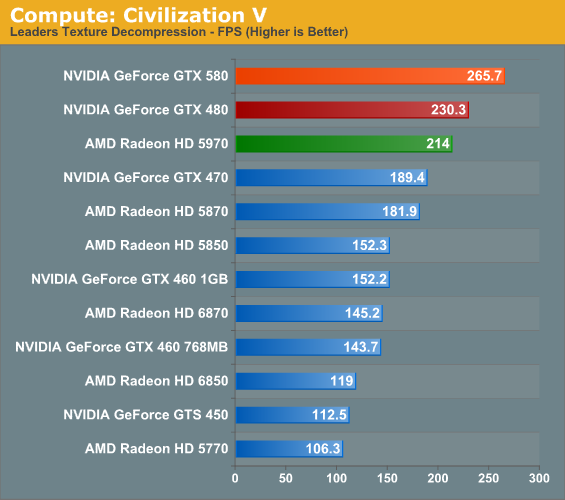
We previously discovered that NVIDIA did rather well in this test, so it shouldn’t come as a surprise that the GTX 580 does even better. Even without the benefits of architectural improvements, the GTX 580 still ends up pulling ahead of the GTX 480 by 15%. The GTX 580 also does well against the 5970 here, which does see a boost from CrossFire but ultimately falls short, showcasing why multi-GPU cards can be inconsistent at times.
Our second compute benchmark is Cyberlink’s MediaEspresso 6, the latest version of their GPU-accelerated video encoding suite. MediaEspresso 6 doesn’t currently utilize a common API, and instead has codepaths for both AMD’s APP (née Stream) and NVIDIA’s CUDA APIs, which gives us a chance to test each API with a common program bridging them. As we’ll see this doesn’t necessarily mean that MediaEspresso behaves similarly on both AMD and NVIDIA GPUs, but for MediaEspresso users it is what it is.
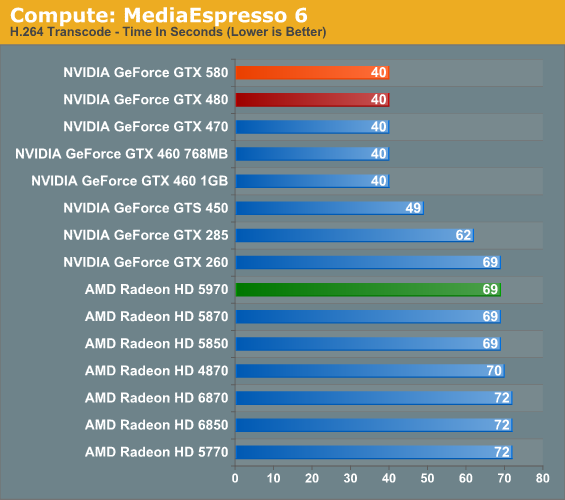
We throw MediaEspresso 6 in largely to showcase that not everything that’s GPU accelerated is GPU-bound, as ME6 showcases this nicely. Once we move away from sub-$150 GPUs, APIs and architecture become much more important than raw speed. The 580 is unable to differentiate itself from the 480 as a result.
Our third GPU compute benchmark is SmallLuxGPU, the GPU ray tracing branch of the open source LuxRender renderer. While it’s still in beta, SmallLuxGPU recently hit a milestone by implementing a complete ray tracing engine in OpenCL, allowing them to fully offload the process to the GPU. It’s this ray tracing engine we’re testing.
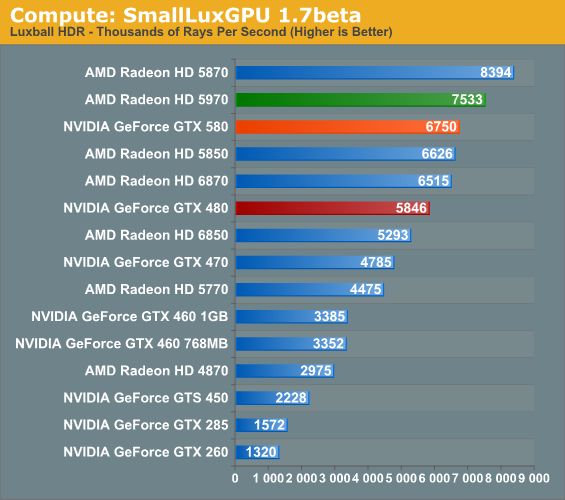
SmallLuxGPU is rather straightforward in its requirements: compute and lots of it. The GTX 580 attains most of its theoretical performance improvement here, coming in at a bit over 15% over the GTX 480. It does get bested by a couple of AMD’s GPUs however, a showcase of where AMD’s theoretical performance advantage in compute isn’t so theoretical.
Our final compute benchmark is a Folding @ Home benchmark. Given NVIDIA’s focus on compute for Fermi and in particular GF110 and GF100, cards such as the GTX 580 can be particularly interesting for distributed computing enthusiasts, who are usually looking for the fastest card in the coolest package. This benchmark is from the original GTX 480 launch, so this is likely the last time we’ll use it.
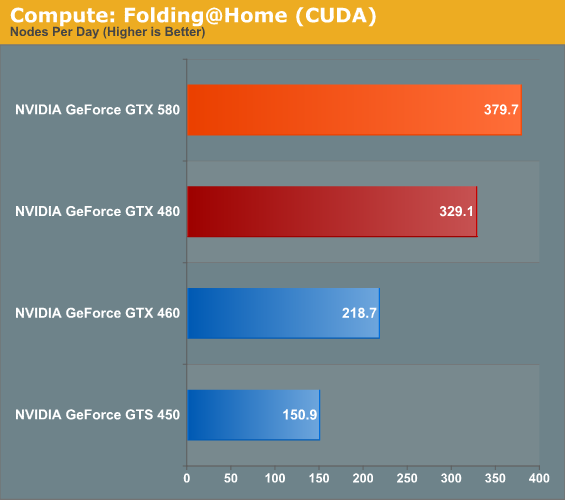
If I said the GTX 580 was 15% faster, would anyone be shocked? So long as we’re not CPU bound it seems, the GTX 580 is 15% faster through all of our compute benchmarks. This coupled with the GTX 580’s cooler/quieter design should make the card a very big deal for distributed computing enthusiasts.
At the other end of the spectrum from GPU computing performance is GPU tessellation performance, used exclusively for graphical purposes. Here we’re interesting in things from a theoretical architectural perspective, using the Unigine Heaven benchmark and Microsoft’s DirectX 11 Detail Tessellation sample program to measure the tessellation performance of a few of our cards.
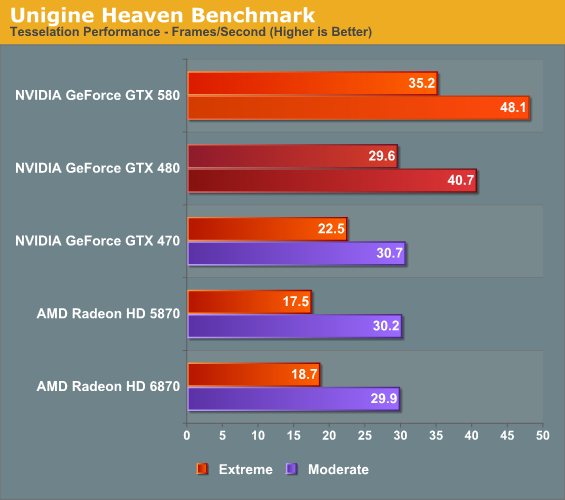
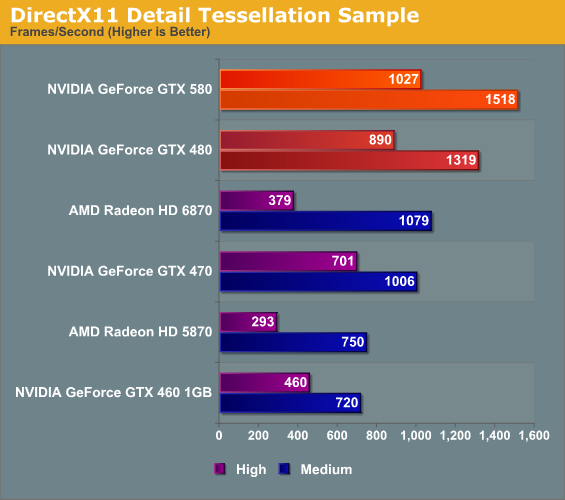
NVIDIA likes to heavily promote their tessellation performance advantage over AMD’s Cypress and Barts architectures, as it’s by far the single biggest difference between them and AMD. Not surprisingly the GTX 400/500 series does well here, and between those cards the GTX 580 enjoys a 15% advantage in the DX11 tessellation sample, while Heaven is a bit higher at 18% since Heaven is a full engine that can take advantage of the architectural improvements in GF110.
Seeing as how NVIDIA and AMD are still fighting about the importance of tessellation in both the company of developers and the public, these numbers shouldn’t be used as long range guidance. NVIDIA clearly has an advantage – getting developers to use additional tessellation in a meaningful manner is another matter entirely.










160 Comments
View All Comments
AnandThenMan - Wednesday, November 10, 2010 - link
"Relevent models only please, that have the same performance as the GTX580."So we can only compare cards that have the same performance. Exciting graphs that will make.
RobMel85 - Tuesday, November 9, 2010 - link
I browsed through the 10 pages of comments and I don't think I saw anyone comment on the fact that the primary reason Nvidia corrected their heat problem was by blatantly copying ATi/Sapphire...not only did they plagiarize the goodies under the hood, but they look identical to AMD cards now! Our wonderful reviewer made the point, but no one else seemed to play on it.I say weak-sauce for Nvidia, considering the cheapest 580 on NewEgg is $557.86 shipped; the price exceeds what 480 was initially and the modded/OC'd editions aren't even out yet. It can't support more than 2 monitors by itself and is lacking in the audio department. Yes, it's faster than it's predecessor. Yes, they fixed the power/heat/noise issues, but when you can get similar, if not better, performance for $200 less from AMD with a 6850 CF setup...it seems like a no brainer.
Sure ATi re-branded the new cards as the HD6000 series, but at least they aren't charging top $ for them. Yes, they are slower than the HD5000 series, but you can buy 2 6850s for less than the price of the 480, 580, 5970(even 5870 for some manufacturers) and see similar or better performance AND end up with the extra goodies the new cards support.
I am looking forward to the release of the 69XX cards to see how well they will hold up against the 580. Are they going to be a worthy successor to the 5900, or will they continue the trend of being a significant threat in CrossFire at a reasonable price? Only time will tell...
The real question is, what will happen when the 28nm HD7000 cards hit the market?
tomoyo - Tuesday, November 9, 2010 - link
Actually the newegg prices are because they have a 10% coupon right now. I bet they'll go back to closer to normal after the coupon expires...assuming there's any stock.Sihastru - Wednesday, November 10, 2010 - link
Vapour chamber cooling technology was NOT invented by ATI/Sapphire. They are NOT the first to use it. Convergence Tech, the owner of the patent, even sued ATI/Sapphire/HP because of the infringement (basically means stolen technology).LOL.
RobMel85 - Sunday, November 14, 2010 - link
Where within my post did I say it was invented by ATi/Sapphire...nowhere. The point that I was trying to make was that Nvidia copied the design that ATi/Sapphire had been using to trounce the Nvidia cards. The only reason they corrected their problems was by making their cards nearly identical to AMD/ATi...And to tomoyo, when I made that post there was no 10% coupon on newegg. They obviously added it because everyone else was selling them cheaper.
Belard - Wednesday, November 10, 2010 - link
This is still a "400" series part as it's really technically more advanced than the 480.Does it have additional features? No.
Is it faster, yes.
But check out the advancement feature list.
The 6800s, badly named and should have been 6700s, are slightly slower than the 5800s, but costs a lot less and actually does some things differently from the 5000 series. And sooner or later, there will be a whole family of 6000s.
But here we are, about 6months later and theres a whole new "product line"?
dvijaydev46 - Wednesday, November 10, 2010 - link
Is there any problem with Mediaespresso? My 5770 is faster with mediashow than mediaespresso. Can you check with mediashow to see if your findings are right?Oxford Guy - Wednesday, November 10, 2010 - link
The 480 beats the 580, except at 2560x1600. The difference is most dramatic at 1680x1050.http://techgage.com/reviews/nvidia/geforce_gtx_580...
http://techgage.com/reviews/nvidia/geforce_gtx_580...
http://techgage.com/reviews/nvidia/geforce_gtx_580...
Why is that?
Sihastru - Wednesday, November 10, 2010 - link
Proof that GF110 is not just a GF100 with all the shaders enabled.Oxford Guy - Wednesday, November 10, 2010 - link
This seems to me to be related to the slight shrinkage of the die. What was cut out? Is it responsible for the lower minimum frame rates in Unigine?